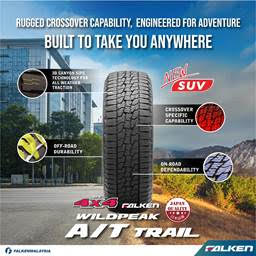How do we pick the best tyres that suit our vehicle and driving application? What do HT, AT, RT, and MT stand for? What are the main features within each category? To answer all these questions and to give our readers a better understanding of the tyres’ main selling points, we talked to Frankie Kong, Head of Sales for SUV & 4X4, Stamford Tyres Malaysia.
“There are ample types of 4×4 tyres and brands in the market, so drivers have to have an idea of the exact differences of each type of tyre and what they can offer to ensure they make the appropriate choice for their vehicle. The Highway Terrain (HT), All-Terrain (AT) and Mud-Terrain (MT) are the three categories of 4X4 tyres that we are more familiar here in Malaysia. A new category of tyre – the Rugged Terrain (RT) also surfaced within the market fairly recently,” Kong explained.
HT tyres are the most similar to standard passenger car tyres, and are mainly for paved road usage, he explained. They are designed to provide a smooth, quiet and comfortable drive with a higher speed rating and lower load index. Their sidewall and tread areas are not specifically designed for puncture resistance, therefore the tyre is not really designed for off-road performance. HT tyres, he pointed out are suitable for 4WD drivers that have limited off-road exposure.
“The disadvantages of these tyres include unstable cornering performance, less resistance for hydroplaning, as well as a limited range of sizes to choose from. They account for less than 10 per cent of the total 4×4 tyre market.”
Amongst the four categories AT tyres are the most popular, which amount to about 80 per cent of the local 4×4 tyre market, he noted. “As their name suggests, all terrains tyres are perfect all-rounders. They offer 4×4 drivers a balance between off-road capabilities and everyday paved road use, with a moderate speed rating and load index. With large, staggered tread blocks and thicker sidewalls, this makes the tyre a better option for off-road terrains without compromising on on-road comfort and performance. The grip on concrete roads is also better, thanks to the siped tread blocks. In terms of noise, they are louder than HT tyres but quieter than MT tyres. This is due to their optimised pattern arrangement – a block distribution with variable pitch sizes for low noise performance.”
However, he stressed that although AT tyres can handle various off-roading conditions, they are not suitable for deep mud.
RT, as mentioned above, is a new segment. Kong explained that RT tyres are the response from tyre manufacturers and marketers to the needs of their consumers, who want a tyre that fits in between the AT and MT segments.
“We also call them hybrid-terrain tyres, which means they are more or less a combination of AT and MT tyres. These tyres can conquer rugged terrain conditions that regular AT tyres are unable to handle, including loose terrain, deep mud, rocky and severely uneven surface.”
The tread design of RT tyres, he said, is similar to mud-terrain models. Featuring a sporty staggered tread pattern, large open voids and a knobby sidewall tread to help move the (how about disperse instead of move) mud, these tyres also have siped tread lugs to improve traction in wet conditions.
“The drawback is that RT tyres are not suitable for tropical countries with high rainfalls, such as Malaysia, as they do not have much grip on wet roads like a standard MT tyre. They are also not as comfortable as an AT tyre. At present, RT tyres occupy only about 2 per cent of the 4×4 market,” he added.
Last but not least is the MT tyres, which he said are designed for 4X4 owners who use their vehicle for 80 per cent and above off-road activities. These tyres feature large and staggered tread blocks similar to AT tyres, but the void area between these tread blocks is wider. He explained that the high void ratio of the MT tyres enables them to conquer muddy and rocky conditions with ease.
“Their on-road performance is not as good as HT or AT tyres. With higher rolling resistance, the level of noise from the road and the higher fuel consumption, combined with the void ratio, which reduces their on-road traction, are issues that drivers will need to consider.”
As MT tyres tend to wear unevenly, the mileage is lower when compared to the other three types of tyres. Currently, only about 5 per cent of the total 4×4 tyre market is taken up by MT tyres.
Kong concluded that there is no such thing as the best tyre, only the right one for your vehicle – better yet, the most appropriate for your vehicle. “It is vital to choose the right tyres to ensure your 4WD performs well in different driving conditions. The application of 4WDs vary and one has to think of their usage before deciding on what tyres to buy.”

